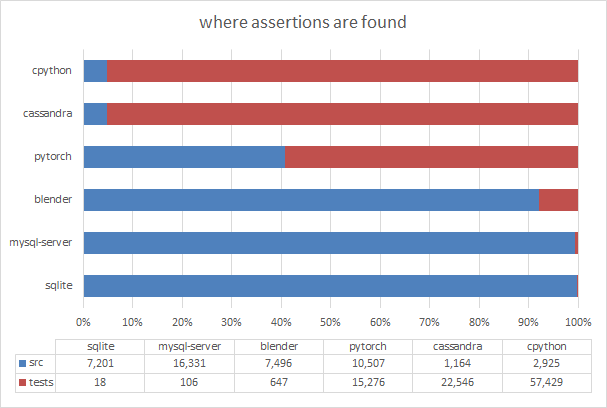„Wait, you can use
assertoutside of unit tests?“
This question of a junior programmer in our team ultimately started the thought process that became this article. It wasn’t the only motivation, but more on that later.
Assertions and unit testing
Assertions are pieces of code that make sure a certain expectation of the developer holds at that position in the control flow. If the expectation is violated, the program is terminated then and there and a bit of (hopefully) helpful context is printed. If you’re working from a decent IDE, it may even “catch” the assertion and offer for a debug session to be started to inspect the situation and variables at the time of the failure.
History
You probably encounter assert much more frequently when working in unit test code. Unit testing frameworks have adapted the concept of assert and enhanced it with many useful variants/helpers like
- Assert.AreEqual
- clojure.test/is
- unittest.TestCase.assertNotIn
- Assert.That
- EXPECT_NEAR
- rackunit/check-match
- pytest.raises
Pytest even takes charge of Python’s assert statement—that could be the origin of our junior’s misconception. But ignoring that hijacking, Python has its own assert statement and these assertions, that don’t come from unit testing suites but are part of a language, are the ones this is about.
Looking at the pervasive use of the word “assert” in unit tests, the concept is quite similar. Like an assertion, a unit test is an expression of a developer’s expectation of what is supposed to happen. Only that unit tests usually are more involved, may take (a little) longer and might require setup or tear-down code. An additional constraint of the assertions listed above is that they have a dedicated habitat; they should exclusively be found in your unit testing code.
But it’s not like unit tests invented assert. The latter found their way into source code in the mid-60s as the Algol W Language Description corroborates. The most prominent incarnation probably is the macro assert from C’s standard library from 1978. Kent Beck popularized unit testing for software development more than a decade later. So that’s a sound “yes” to the opening question; otherwise assert would have felt awfully useless for 22 years.
Assertion Resistance
That brings me to my second motivational point. In code reviews, I sometimes received comments like this, also from seniors:
No assertions in production code.
The first time I was baffled. I defended my stance for that particular case and merged after we had settled the dispute. But it kept happening and I kept having to justify single asserts. In companies I worked before, we had quite a lot of assertions in our production code and I had never been confronted with that view before.
Clearing misconceptions
One common “warning” was that assertions are dropped for release builds. Yes, that is the default and I’m aware of that. Here we come to a very important distinction that we have to make: asserting is no exception handling! Those are two very different tools for different jobs. Assertions are for the developer and the developer only. If they fail, the code has a bug! There’s nothing a user of the software could do.
So I want assertions to fail for the developer; and suitably most of the time we write, test and debug our software in debug mode. That’s also when you can still do something about it (because remember, failing one indicates a bug). Neat!
Besides, nobody forbids leaving assertions on for release mode. With ever-faster hardware, some companies are switching to leaving them in. John Reger [1] cites valgrind as a well-known tool that profits from always-on assertions.
After all, it might be better to fail ungracefully than to continue with an unknown/corrupted state—Erlang anyone? There is one important caveat, however: never assert on something with side effects (like assert(v.erase(it) != v.end());
What to use them for (and for what not)
For things like input validation, network communication and other things that are not under your control, definitely use exceptions and stay away from assert. But when you at some point want to make sure that you didn’t mess up transitions of your state machine, that’s a job for an assert. In general, checking invariants is the poster child for using assertions. Not only do they alert you when you messed up rewriting something, but they also serve as documentation. It gets even better, it is documentation that cannot get out of date!
So instead of a passive and inconspicuous
# We should never get here.
put a
assert False, "Did you introduce a new state and forgot to handle it here?"
and feel the relief of crossing that plot of your worry list.
Don’t take “state machine” too literally here. You can also use it three function calls deep to assert on something that the outer-most function should have already established (e.g. assert len(self.queue) > 1).
Overview
To summarize let’s contrast a few things from both techniques.
| Assertion | Exception Handling | |
|---|---|---|
| context | things under your control | expected but also unforeseeable failures |
| context | must not happen | contingency we might have to deal with |
| think | “Better safe than sorry.” | “How can this go wrong and can I do something about it?” |
| integration | quiescent almost always | part of your code flow/logic |
| for whom | developer | developer/user |
| complexity | keep cheap | can become complex if need be |
| switchable | may be dropped in release mode | always there |
| effect | in your face ⇒ get to programming | catchable/suppressible |
Assertions in the field
I wanted to see who would back this opinion, so I looked for a couple of open-source projects and downloaded their repositories. Then I manually divided source code into implementation and test folders and ran a script that raffishly skips comments and tallies what counts as an assert (adapted for the found languages LISP, Lua, JavaScript/TypeScript, Python, Java and of course the C family). As opposed to what I wrote above, I did also look for the various assertions from unit testing frameworks to generate this graph. First, because of my reasoning that plain assert and unit testing share a common ground. Second, it wouldn’t have been a very interesting comparison otherwise.
Results

Ordered by increasing the percentage of assertions in the implementation, we start with CPython (implemented in C as the name implies) and Cassandra (Java). 95 % of all assertions are to be found in the tests. Nevertheless, I wouldn’t want to debate over the remaining approx. 4,000 assertions in production code.
PyTorch (C++) shows a stark increase to an almost balanced distribution (41 %). The 3D modeler Blender is again implemented in C++ and has 92 % of all assertions in the implementation. To be fair, testing seems to be done exclusively in Python (i.e. fewer lines of code) and there aren’t that many tests in general. MySQL (another C++ project) on the other hand has quite a few tests, but they dwindle compared to the amount of code (and asserts) in the implementation.
For SQLite, the situation is distorted. We do find about a dozen assert in the tests, but it’s not what the project uses for testing. Instead, there are about 10,000 files with a .test extension. Looking inside, we find a kind of a DSL to allow for plain SQL statements and subsequent tests of their effects/results. So it seems well tested but has almost all assertions in the implementation.
Conclusion
As you see, there’s great variety; from most asserts in the implementation over a balanced mix to the majority in tests. But looking at these examples, even the latter doesn’t strike me as written against a “no asserts in production code” rule. As laid out above, I argue that the statement should rather be “no asserts instead of exceptions.”
As an additional perspective, consider code contracts, a heavy-duty version of assert (since the beginning in Eiffel and more recently available in .NET for instance). They let you specify
- pre- and post-conditions for methods, and
- invariants for classes that hold before/after every method call.
And just like assertions they can—and more likely are due to much higher costs—compiled out for release builds. Unlike assertions, you only put them on your production code, because that’s what they describe.
So if they are mightier assert and belong in production code, why would you not put the assert there, too?
What are you waiting for? To say it in Python:
assert "assert" in production_code
Further reading
- [1] Use of Assertions
- A Historical Perspective on Runtime Assertion Checking in Software Development
- Assert in production code? Yes, please! - 21. Dezember 2021
- Advent of Code 2020 – Weihnachtsstimmung mal anders - 24. Februar 2021



